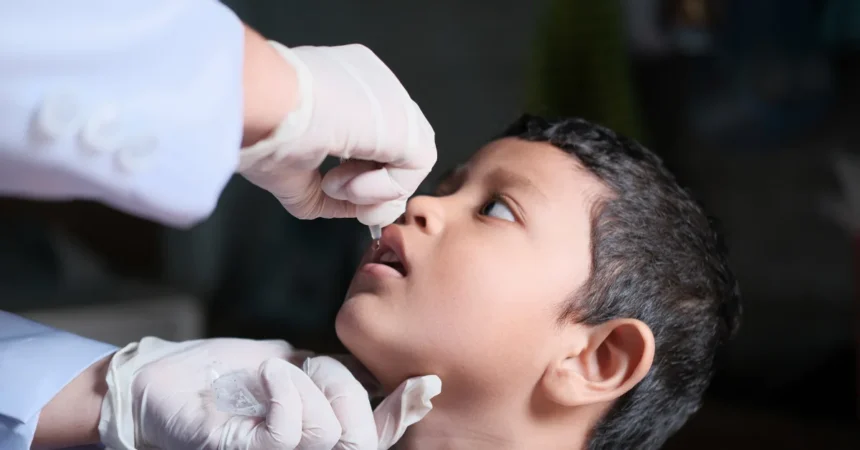In a concerning development for public health, Pakistan has witnessed a rise in polio cases, with the count reaching 32 as of October 2024. This spike in polio cases highlights the ongoing struggle to eradicate the virus despite years of vaccination campaigns, government efforts, and international support. Polio, a crippling and sometimes deadly disease, was once on the brink of elimination in Pakistan. However, challenges such as misinformation, vaccine hesitancy, and gaps in healthcare infrastructure have caused a resurgence, threatening the health of children and the overall progress toward global eradication.This article delves into the details of Pakistan’s polio situation, the factors behind the rising number of cases, the strategies being employed to counter the spread, and the broader implications for the country’s public health system.
The Rise of Polio Cases in 2024
The year 2024 has seen a sharp rise in polio cases in Pakistan, with 32 reported infections across various provinces. The cases have primarily emerged in areas with limited access to healthcare, poor sanitation, and populations resistant to vaccinations due to cultural or religious misconceptions.
Polio, caused by the poliovirus, primarily affects children under the age of five, leading to irreversible paralysis in some cases. While the virus was nearly eradicated in Pakistan during the early 2010s, the recent resurgence is alarming for healthcare workers and policymakers alike. The increasing number of cases underscores the challenges in achieving the ultimate goal of making Pakistan polio-free.
According to health officials, the new cases are concentrated in regions with historically low immunization coverage, such as parts of Khyber Pakhtunkhwa and Balochistan. Despite aggressive vaccination drives, many communities remain hard to reach due to security concerns, misinformation about vaccines, and logistical hurdles.
Key Challenges Behind the Surge in Polio Cases
Several factors have contributed to the resurgence of polio in Pakistan. Understanding these challenges is crucial to addressing the issue and preventing further spread.
- Misinformation and Vaccine Hesitancy: One of the biggest obstacles to eradicating polio in Pakistan is misinformation about the vaccine. False rumors that the polio vaccine contains harmful substances or that it causes infertility have led to widespread resistance in some communities. Anti-vaccine sentiments, often fueled by social media and local myths, have caused parents to refuse to vaccinate their children, creating gaps in immunity.Misinformation campaigns are particularly prevalent in rural areas where access to accurate health information is limited. In some cases, influential religious leaders have opposed vaccination efforts, convincing their followers to avoid immunization. This mistrust in vaccines has made it difficult for health workers to carry out successful vaccination campaigns, especially in regions that are already vulnerable to disease outbreaks.
- Security Concerns and Attacks on Health Workers: Another significant challenge is the safety of health workers involved in vaccination campaigns. In some parts of Pakistan, especially in the tribal regions and Khyber Pakhtunkhwa, polio vaccination teams have been targeted by militant groups. These attacks, often violent and fatal, have led to the suspension of vaccination drives in high-risk areas, leaving children unprotected from the virus.
Health workers in Pakistan have been on the frontlines of polio eradication efforts for years, but the dangerous conditions in which they operate hinder the effectiveness of their work. The repeated targeting of polio teams has created fear among healthcare professionals, making it difficult to maintain consistent immunization coverage in conflict-affected areas. - Lack of Access to Healthcare and Sanitation: Many polio cases in Pakistan arise from regions with inadequate healthcare infrastructure and poor sanitation facilities. In remote areas, people often lack access to basic health services, clean water, and proper sanitation, creating an environment conducive to the spread of the poliovirus.
The combination of poor living conditions and limited access to vaccines makes it easy for the virus to spread rapidly in communities. While urban centers may have more robust healthcare systems, rural and impoverished areas struggle to provide even basic medical services, contributing to the persistence of polio. - Population Mobility and Refugees: Another complicating factor is population mobility, particularly in areas along the Pakistan-Afghanistan border. Frequent movement of people across borders, including refugees and internally displaced persons, has led to the reintroduction of the virus in areas previously thought to be free of polio. The influx of unvaccinated children into communities poses a significant risk to the success of vaccination campaigns.
Afghanistan, which also faces its own challenges with polio, shares a porous border with Pakistan, making it difficult to completely isolate outbreaks. Collaborative efforts between the two countries are essential, but regional instability has made sustained cooperation difficult. - Insufficient Resources and Support: Despite international funding and support, polio eradication efforts in Pakistan have sometimes struggled due to insufficient resources. Vaccination campaigns require significant logistical planning, healthcare personnel, and financial resources. In some cases, the necessary funds to carry out mass immunization drives may not be allocated in time, delaying crucial efforts to vaccinate children.
Additionally, the COVID-19 pandemic temporarily disrupted vaccination campaigns, as resources and attention were diverted toward combating the virus. As a result, polio vaccination efforts were scaled back during the height of the pandemic, leading to immunity gaps in vulnerable populations.
Government and International Efforts to Eradicate Polio
Pakistan’s government, in collaboration with international organizations such as the World Health Organization (WHO), UNICEF, and the Global Polio Eradication Initiative (GPEI), has been working tirelessly to eliminate polio from the country. Various strategies have been implemented to counter the spread of the virus and address the root causes of the resurgence.
- Mass Vaccination Campaigns: The cornerstone of Pakistan’s polio eradication strategy is the implementation of mass vaccination campaigns. These campaigns aim to immunize every child under the age of five, regardless of whether they have been previously vaccinated. The government has organized national immunization days (NIDs), during which millions of children are vaccinated in a coordinated effort to boost immunity.
Mobile vaccination teams have been deployed to reach children in remote and hard-to-access areas. In some cases, teams travel door-to-door to ensure that no child is left behind. The goal is to achieve “herd immunity,” wherein a sufficient portion of the population is immunized to prevent the virus from spreading within communities. - Increased Surveillance: Surveillance is critical for tracking the spread of the poliovirus and identifying new cases in real-time. Pakistan’s health authorities, in collaboration with international partners, have established an extensive network of surveillance sites across the country to monitor the circulation of the virus.
Environmental surveillance, which involves testing sewage samples for traces of the poliovirus, has been particularly effective in detecting the virus in urban areas. By identifying areas where the virus is present, health officials can target vaccination efforts and contain outbreaks before they spread further. - Public Awareness Campaigns: Addressing misinformation and vaccine hesitancy requires comprehensive public awareness campaigns. The government and international organizations have launched initiatives to educate communities about the safety and importance of the polio vaccine. These campaigns often feature endorsements from religious leaders, community influencers, and healthcare professionals to build trust and counter false narratives about vaccination.
Radio, television, and social media are used to disseminate accurate information about the polio vaccine. Additionally, health workers engage directly with community members to address their concerns and dispel myths about the vaccine. - Partnerships with Religious Leaders: Recognizing the influence of religious leaders in shaping public opinion, the government has sought to collaborate with religious figures to promote vaccination. By gaining the support of clerics and imams, health officials aim to break down cultural and religious barriers to vaccination.
In areas where resistance to vaccination is strong, religious leaders have played a crucial role in encouraging parents to vaccinate their children. These partnerships have helped to counteract anti-vaccine sentiment and increase immunization coverage in resistant communities. - Improved Security for Health Workers: Ensuring the safety of health workers is crucial for the success of polio vaccination campaigns, especially in high-risk areas. The government has strengthened security by providing police escorts and special protection during national immunization days. Despite these measures, the threat to health workers persists, making ongoing security improvements vital for uninterrupted vaccination efforts.
- Cross-Border Coordination with Afghanistan: Cross-border coordination between Pakistan and Afghanistan is essential to eradicate polio in both countries. Joint initiatives, like synchronized vaccination campaigns, target children at transit points and border crossings to prevent the virus’s spread. Collaboration between both governments, with international support, is crucial for achieving polio eradication in the region.
The Broader Impact of the Polio Crisis on Pakistan
The resurgence of polio in Pakistan has far-reaching implications for the country’s public health system and its global reputation. While the government remains committed to eradicating the virus, the persistence of polio poses several challenges.
- Strain on Healthcare Resources: The rise in polio cases places additional strain on Pakistan’s already overburdened healthcare system. Resources that could be used for other health initiatives are diverted to combat the polio crisis. This can affect the country’s ability to address other pressing health issues, such as maternal and child health, infectious diseases, and malnutrition.
- Economic Consequences: Polio outbreaks have economic consequences as well, as they require significant financial investments in vaccination campaigns, healthcare infrastructure, and surveillance systems. Moreover, the inability to eradicate polio can affect international trade and tourism, as countries that fail to control the virus may face travel restrictions or reduced foreign investment.
#PolioPakistan #PolioEradication #Vaccination #HealthCrisis #PublicHealth #PolioSurge #VaccineHesitancy #PakistanPolio #Misinformation #Immunization #HealthcareChallenges #EndPolioNow







